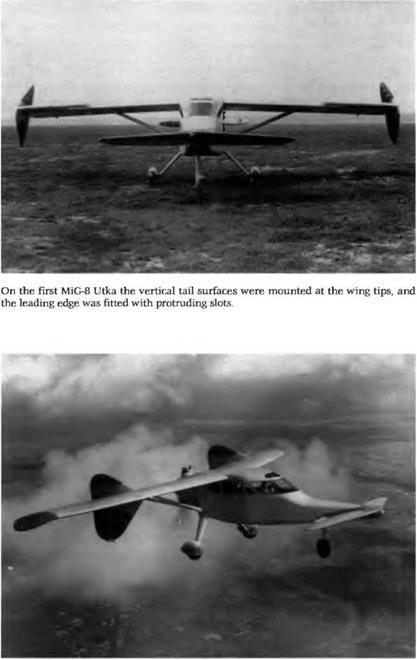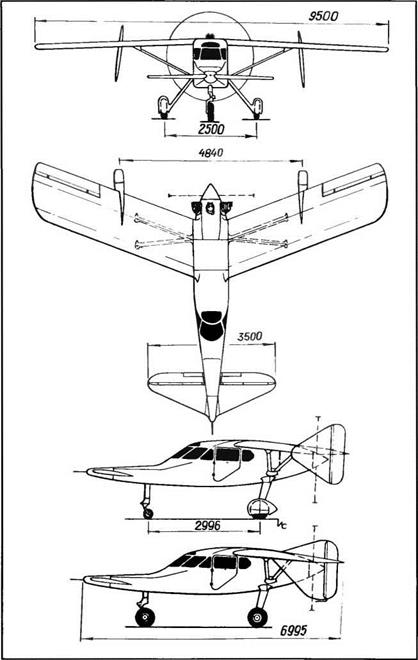MiG-В / Utka
A few months before the start of World War II, at the dawn of the jet era, members of the MiG design department started to gather and test various ideas for future aircraft. For this purpose, they decided to build an experimental prototype: an unconventional canard, or tail-first, machine (canard is French for duck). This is how Mikoyan and Guryevich justified their enterprise in a note enclosed with the preliminary design:
The canard-tailed aircraft we have designed and that is now being built is an experimental machine intended to check the maneuverability and steadiness in flight of that type of aircraft and to verify the characteristics of highly swept wings. We have chosen the pusher-prop formula because it will enable us to check the low-speed handling with a wing that will not be blown by the propeller. This point is of special interest for aircraft powered by jet engines. The Utka ["duck”] will be a useful tool with which to examine thoroughly all the problems of handling, taxiing, takeoff, and landing (including go-around and touch-and-go) without any propeller slipstream effects on control surfaces.
In conceptualizing the Utka or MiG-8, the ОКБ project engineers had in mind the installation of a jet engine on an airframe of the same layout so that its hot exhaust gases would keep away from all structural elements. The design was prepared in close cooperation with a team of TsAGI technicians. The MiG-8 had a high wing braced by V-shaped struts with a two-spar fabric-covered wooden structure that displayed a 12 percent constant thickness ratio. The wing’s forward sweep angle was 20 degrees at the leading edge with a 2-degree anhedral. The fuselage, fins, rudders, and canard surfaces were made of wood.
The Utka was fitted with a fixed tricycle landing gear (a first for a MiG aircraft). The cabin had room for three people, with the pilot in front. Lateral and forward visibility was excellent because of the high position of the wing and the fact that the engine was in the rear. The engine bay and the fuselage were aerodynamically well matched.
The elevator was controlled by a rod and a bellcrank, while the rudder and ailerons were controlled by cables. The two duralumin fuel tanks had a total capacity of 195 1 (51 US gallons) and were located in the center section of the wing. The 18-1 (4.7-US gallon) oil tank was located behind the cabin. The air-cooled Shvetsov-Okromeshko M-11F radial engine offered 81 kw (110 ch) and was entirely cowled with the

|
|

exception of the cylinder heads. The two-bladed, fixed-pitch propeller was made of wood and measured 2.36 m (7 feet, 8.9 inches) in diameter. Gear legs were constructed of welded metal with pneumatic shock absorbers; the front wheel (300 x 150 initially) had an oleo strut. The wheels of the main gear (500 x 150) were fitted with pneumatic brakes. Later, the wheel sizes were standardized at 500 x 150. The Utka was flown in 1945 for the first time by test pilot A. I. Grinchik. The two fins were then located at the wing tips, and the leading edge was fitted with protruding slots. The two fins were later moved to midspan. The rudders were fitted with balance weights, and the leading edge slots were removed. The ОКБ also tried out wing tips with a strong anhedral.
The MiG-8 was remarkable for its outstanding stability, refusing to spin even when used at great angles of attack. Many OKB pilots such as A. N. Grinchik, A. I. Zhukov, A. N. Chernoburov, and chief engineer E. F. Nashchyekin spent a great deal of time at its controls. Because of its outstanding flying qualities, safety and ease of handling, and low manufacturing costs, the OKB tried to sell the aircraft to Aeroflot, hut the offer was not taken into account. The plane served as the design bureau’s liaison aircraft for several years.
Specifications
Span, 9.5 m (31 ft 1.9 in); span of the canard surfaces, 3.5 m (11 ft 5.8 in); length, 6.995 m (22 ft 11.4 in); wheel track, 2.5 m (8 ft 2.4 in); wheel base, 2.996 m (9 ft 10 in); wing area, 15 m2 (161.5 sq ft); empty weight, 642 kg (1,415 lh); takeoff weight, 997 kg (2,197 lb); max takeoff weight, 1,150 kg (2,535 lb); fuel, 140 kg (309 lh); oil, 14 kg (31 lh), wing loading, 66.5/76.7 kg/m2 (13.6/15.72 lb/sq ft); aircraft balance, 8% MAC.
Performance
Max speed, 205 km/h (111 kt); landing speed, 77 km/h (42 kt), range, 500 km (310 mi).










